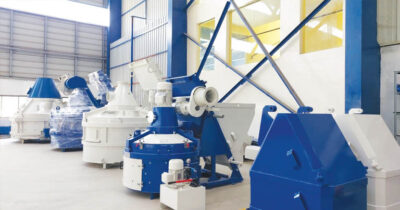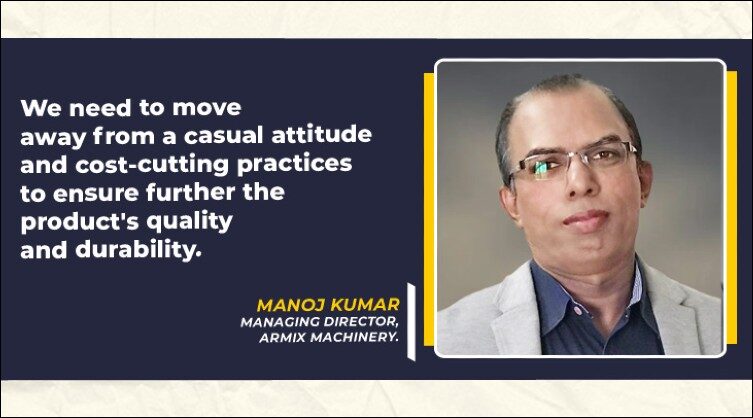Our main priorities are identifying and establishing relationships with potential customers, brand image, and product launches. It’s always a pleasure to participate at Bauma as it’s the ideal platform to launch and introduce your innovative products and solutions, says Manoj Pillai, Managing Director of Armix Machinery.
What will be your primary focus at bauma 2023?
Product introductions are crucial in any sector, in addition to pricing, quality, technology, and services. At trade exhibitions like BC India, which is one of the largest in India and is expertly organised under the well-known brand, we could always count on receiving high-quality attendees, including decision-makers. Any exhibitor will benefit from this, and it will be simpler for potential customers to view the newest technology features and advantages on a single platform. It takes a lot of work to attract the interest of every potential buyer, particularly in a vast country like India. Due to many factors, it is challenging to attract the attention of all potential buyers to the facility, particularly in a big country like India, and this will be the finest platform to demonstrate.
Most big product launches in India occur in the south, where product awareness and acceptability are higher than in other sections. The major markets are in the west and north, and it is usually late in the east, which we plan to improve in the future years. While bauma is taking place in the north, we will revise the assumption because states such as UP, Himachal Pradesh, Uttarakhand, Haryana, and Bihar are moving quicker than projected.

What are your thoughts on digitalising construction operations in the coming years?
There are many thoughts in this direction, but progress will take time. As you are aware, the pandemic and war scenario have already severely impacted chips and other electronic components, and there are already significant backlogs with important suppliers. The supply chain will take some time to return to normal, and once R&D begins, there may be some technical challenges. Another concern is a need for more skilled personnel for specialised positions. Despite the current boom in the IT sector, coding and electro-mechanical synchronisation are in grave peril. Digitalisation will take its time in such a case, and we must accept the facts. Industrial buyers and operators should become acquainted with the most recent developments, and feedback will help them improve at the next stage. In today’s environment, we can manage several tasks at once, but integrating them into a common platform or system and fine-tuning it will take time. Industrials must be patient and make quick decisions to move with a long-term vision. Building more professionalism and industrial culture in society is unavoidable in an international market.
The construction equipment sector and the government are working together to improve indigenisation. How do you assess India’s export potential in this context?
We appreciate the government’s stand on this problem, but much more pressure and education are needed. As the government makes new recommendations, the bureaucracy should decrease, but conveying even the most basic information to the bottom level poses issues in this fast-paced social media age. Aside from that, the quality and service of Indian construction machinery vendors must significantly improve. The first thing we need to alter is our casual attitude, and cost-cutting practises, which compromise a product’s quality and durability.
R&D is an essential component of any organisation, and as a result, it produces innovations. The government may play an important role here by encouraging greater engagement and platforms to collaborate with domestic firms in the international market. Trade displays are critical, yet India still needs a world-class exposition building comparable to those found in Munich or Dubai. Physical infrastructure, such as buildings, and the best networks, such as metros, parking lots, and hotel amenities, are required.
Bauma management took the initiative a few years ago and successfully ran the performances in other places. Moreover, India is well-known for IT and software, but we need a solid platform to compete with platforms like Ali Baba, and Chinese companies continue to top the search list. We need to modify this perspective through adequate planning with a long-term vision and effective implementation. Sales are the initial step, and effective platforms are required to reach potential purchasers in different regions of the world. I hope the government and other relevant agencies take it seriously and take the necessary steps to enhance Indian equipment for the worldwide market.

In your opinion, which equipment, products, solutions, and developments will drive the industry’s shift to sustainable construction?
We must think of innovating multiple products as specific markets grow with quality projects. They make no compromise in terms of supply or service. Countries such as Abu Dhabi and Saudi Arabia are already taking this step. The potential in the worldwide market differs from that in India. The need for batching and mixing facilities related to concrete road construction and other infrastructure will increase in the coming years. Government institutions such as NHAI and BRO are performing outstanding work around the country. To compete in the global market, we need more robust infrastructural facilities, a research and development team, financial help, skill development, and so on.
How are we addressing project safety and management challenges?
Construction is the backbone of every economy, whether infrastructure, residential, commercial, or industrial. Most governments have previously taken precautions to assure project site safety through various regulations. It is only possible to meet goals on time with sufficient infrastructure. As a result, project delays are another area that must be prioritised, as cost restrictions typically begin with sacrifices in safety and systems in place. This condition must change because producers must maintain quality, safety, and customer service.
How can we manage carbon footprint concerns effectively?
All major economies, including the United States, India, and China, agreed and vowed to cut their carbon footprint. One aspect is the shift from fossil fuels to alternatives such as solar, wind, and nuclear. Solar power plants, electric vehicles, and batteries are all undergoing rapid development and innovation. Countries like India rely more on coal-fired power facilities and must wait to halt them. The by-product of coal is fly ash, which is utilised in landfilling, brickmaking, and cement manufacturing. This must be increased to a zero-waste level, which is easier to achieve. To address this scenario and close the gaps at the source, central-state governments and companies should work together. Let us hope that the relevant authorities are aware of the issue and are taking the necessary steps to ensure the future of mother earth.
For more details visit: https://armixmachinery.com/
Cookie Consent
We use cookies to personalize your experience. By continuing to visit this website you agree to our Terms & Conditions, Privacy Policy and Cookie Policy.


















